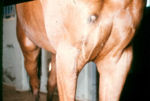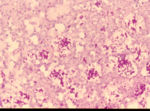Subcutaneous Mycoses
Jump to navigation
Jump to search
| This article is still under construction. |
|
|
Eumycotic Mycetoma
- Pseudoallescheria boydii, Curvularia geniculata, Cochliobolus spicifer, Helminthosporium spp.
- Lives in soil
- Enters the body via wounds
- Granulomatous abscesses
- Microcolonies can be seen grossly in exudate or lesions
- Grains or granules
- Brown or black embedded in granulation tissue
- Small, irregularly shaped
- Infrequent infections of dogs, cats, cattle and horses
- Usually affect the extremities
- Can infect the nasal mucosa
- E.g. Bovine nasal granuloma
- Can also infect the peritoneum and skin
- Can infect the nasal mucosa
- Microscopically:
- Grains of maduromycosis with wide mycelia (compared to actinomycotic granules)
- Chlamydospores present
- Grows on Sabauraud's Dextrose agar
- Slow
- Takes 2-3 weeks
- Treatment includes Ketoconazole, 5-fluorocytosine and amphotericin B
Hyphomycosis
- Hyphomyces destruens
- Opportunistic infection
- Associated with trauma
- Rare
- Caused by Penicillium, Beauveria, Acremonium, Fusarium, Paecilomyces
- Infects both animals and humans
- Mainly affects horses
- Tropical and semi-tropical countries
- Progressive disease causing granulating and ulcerating lesions on the legs and lower body
- Lesions grow rapidly
- Cause extreme debility
- Occurs in water
- Most often seen in ponies with access to ponds
- Chemotactically attracted to horse hair
- Does not respond well to treatment
- Radical surgical excision the best method
- Experiemental vaccination treatment is currently underway and has shown promising results
Pythiosis
- Causes Mycotic Swamp Fever
- Also called phycomycosis
- Occurs in the USA, Australia, New Guinea, India, Brazil, Colombia, Japan, Costa Rica and Indonesia
- Pythium insidiosum
- Granulomatous infection
- Necrosis and fistulous tracts
- Yellow lesions
- Branching, separated fungi
- Progressive (rather than systemic) disease
- Surgery is needed
Rhinosporidiosis
- Rhinosporidium seeberi
- Lives in water
- Causes a chronic, benign disease
- Affects cattle, mules, horses, dogs and humans
- Causes polyps on the nasal and ocular mucous membranes
- Over 90% of cases affecting the nasal mucous membranes affects male animals
- Occurs most frequently in tropical countries
- Also common in the USA
- Large sporangia can be seen on wet mounts
- Endospores visible
- Sporangia develop into small, globose spores
- Treatment is by surgical excision
Sporotrichosis
- Sporothrix schenckii
- Occurs in soil, wood and vegetation
- Saprophyte of both decaying and healthy vegetation
- Worldwide
- Exogenous infections through wounds
- Sporadic infections
- Non-contageous
- Causes subcutaneous nodules or granulomas
- Nodules ulcerate discharging pus
- Spread via the lymphatics
- The bones and viscera can be involved which terminates in mortality
- This is rare
- Reported in dogs and horses
- Affects dogs, horses, cats, monkeys, mules, camels, donkeys, cattle, fowl and rodents
- Most commonly seen in horses as an ascending lymphocutaneous infection of the legs
- Can be confused with epizootic lymphangitis in horses
- Single cell, cigar shaped
- Usually found within neutrophils
- Yeast cell clusters with peripheral eosinophilic rays can be seen in tissue sections
- Stained using PAS, Gram stain (positive), fluorescent antibody and Calcofluor White
- Latex agglutination and immunodiffusion serology can be performed
- Grows on Blood agar and Sabouraud's Dextrose agar in one to three weeks
- At 37°C:
- Colonies are smooth, cream to tan coloured and soft
- No mycelium can be seen
- At 25°C to 27°C:
- Colonies turn from white and soft to tan to brown to black
- Leathery, wrinkled and coarse
- Mycelium can be seen as branching septate hyphae
- Conidiospores can also be seen
- At 37°C:
- Potassium iodide treatment orally
- 5-fluorocytosine and amphotericin B can also be used
Further Links
- Pathology of subcutaneous mycoses

